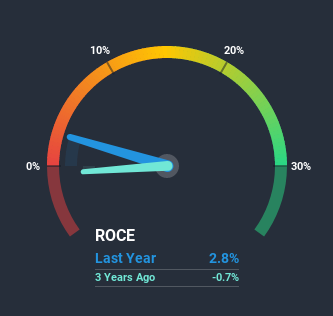- Singapore
- /
- Paper and Forestry Products
- /
- SGX:BEI
What Do The Returns On Capital At LHT Holdings (SGX:BEI) Tell Us?
There are a few key trends to look for if we want to identify the next multi-bagger. In a perfect world, we'd like to see a company investing more capital into its business and ideally the returns earned from that capital are also increasing. Ultimately, this demonstrates that it's a business that is reinvesting profits at increasing rates of return. Having said that, from a first glance at LHT Holdings (SGX:BEI) we aren't jumping out of our chairs at how returns are trending, but let's have a deeper look.
Return On Capital Employed (ROCE): What is it?
If you haven't worked with ROCE before, it measures the 'return' (pre-tax profit) a company generates from capital employed in its business. The formula for this calculation on LHT Holdings is:
Return on Capital Employed = Earnings Before Interest and Tax (EBIT) ÷ (Total Assets - Current Liabilities)
0.028 = S$1.7m ÷ (S$66m - S$5.3m) (Based on the trailing twelve months to June 2020).
So, LHT Holdings has an ROCE of 2.8%. Ultimately, that's a low return and it under-performs the Forestry industry average of 6.5%.
Check out our latest analysis for LHT Holdings

While the past is not representative of the future, it can be helpful to know how a company has performed historically, which is why we have this chart above. If you'd like to look at how LHT Holdings has performed in the past in other metrics, you can view this free graph of past earnings, revenue and cash flow.
What Does the ROCE Trend For LHT Holdings Tell Us?
There are better returns on capital out there than what we're seeing at LHT Holdings. The company has consistently earned 2.8% for the last five years, and the capital employed within the business has risen 31% in that time. Given the company has increased the amount of capital employed, it appears the investments that have been made simply don't provide a high return on capital.
What We Can Learn From LHT Holdings' ROCE
In conclusion, LHT Holdings has been investing more capital into the business, but returns on that capital haven't increased. Although the market must be expecting these trends to improve because the stock has gained 50% over the last five years. However, unless these underlying trends turn more positive, we wouldn't get our hopes up too high.
One final note, you should learn about the 4 warning signs we've spotted with LHT Holdings (including 1 which is shouldn't be ignored) .
While LHT Holdings may not currently earn the highest returns, we've compiled a list of companies that currently earn more than 25% return on equity. Check out this free list here.
If you decide to trade LHT Holdings, use the lowest-cost* platform that is rated #1 Overall by Barron’s, Interactive Brokers. Trade stocks, options, futures, forex, bonds and funds on 135 markets, all from a single integrated account. Promoted
New: AI Stock Screener & Alerts
Our new AI Stock Screener scans the market every day to uncover opportunities.
• Dividend Powerhouses (3%+ Yield)
• Undervalued Small Caps with Insider Buying
• High growth Tech and AI Companies
Or build your own from over 50 metrics.
This article by Simply Wall St is general in nature. It does not constitute a recommendation to buy or sell any stock, and does not take account of your objectives, or your financial situation. We aim to bring you long-term focused analysis driven by fundamental data. Note that our analysis may not factor in the latest price-sensitive company announcements or qualitative material. Simply Wall St has no position in any stocks mentioned.
*Interactive Brokers Rated Lowest Cost Broker by StockBrokers.com Annual Online Review 2020
Have feedback on this article? Concerned about the content? Get in touch with us directly. Alternatively, email editorial-team@simplywallst.com.
About SGX:BEI
LHT Holdings
Manufactures, imports, exports, and trades in wooden pallets and timber-related products in Singapore, Malaysia, and internationally.
Flawless balance sheet with medium-low risk and pays a dividend.
Market Insights
Community Narratives


